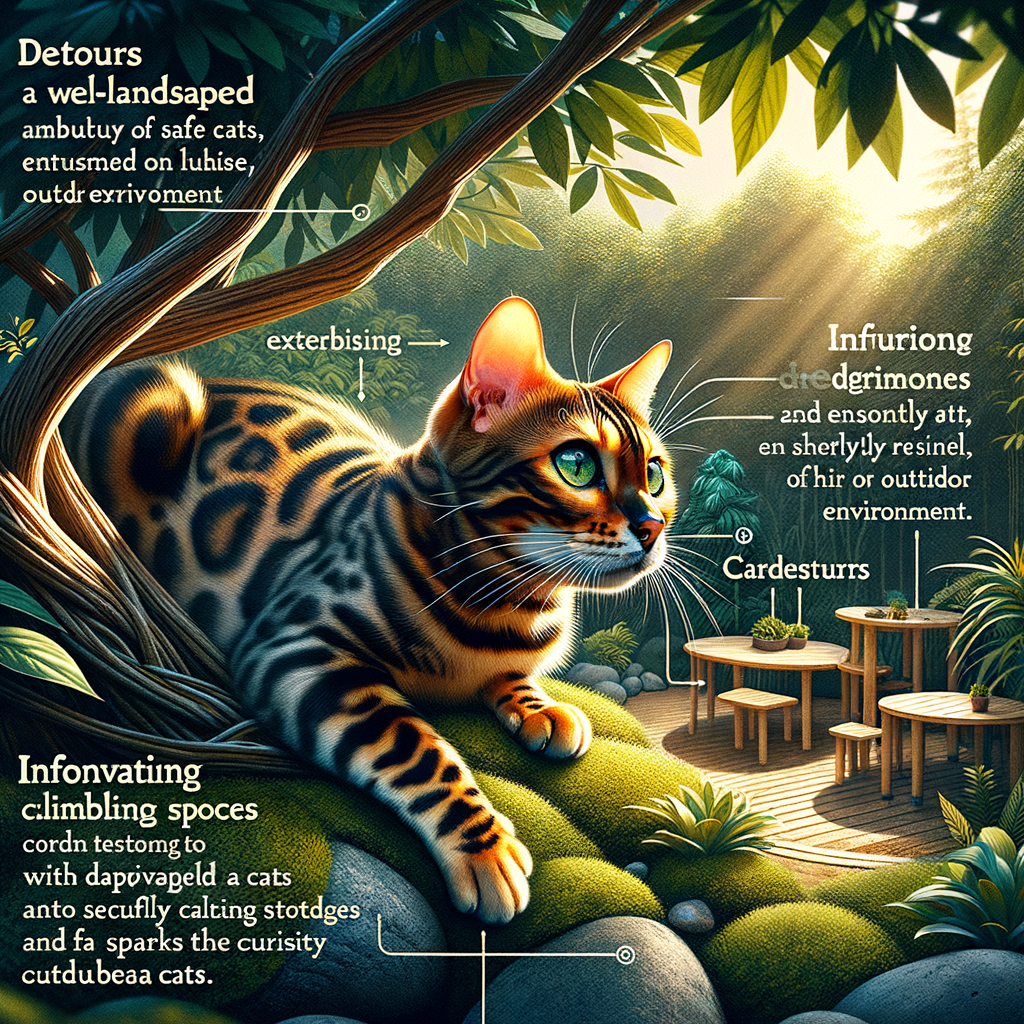
Introduction to Creating a Cat-Friendly Garden
Creating a garden that is safe and enjoyable for your Bengal cat can be a rewarding experience. Bengal cats have unique needs and preferences that should be considered when designing their outdoor space. Let’s explore why a cat-friendly garden is important and the benefits it offers to your Bengal cat.
- Understanding the unique needs of Bengal cats:
Bengal cats are known for their high energy levels and playful nature. They love to climb, explore, and hunt. A garden tailored to these behaviors can keep them happy and healthy.
- Importance of a cat-friendly garden:
A well-designed garden provides a safe environment for your Bengal cat to enjoy the outdoors. It helps prevent them from wandering off and protects them from potential dangers.
- Benefits of outdoor space for Bengal cats:
Outdoor spaces offer Bengal cats the opportunity to exercise, reduce stress, and engage their natural instincts. Fresh air and sunshine can also improve their overall well-being.
Bengal Cat Garden Tips
Designing a Bengal Cat Garden
- Choosing the right location
When designing a garden for your Bengal cat, the first step is to choose the right location. Look for a spot that gets plenty of sunlight but also has shaded areas. Bengal cats love to bask in the sun, but they also need a cool place to rest.
- Creating a layout for the garden
Next, create a layout for your garden. Think about where you will place plants, pathways, and play areas. Make sure there is enough space for your Bengal cat to roam and explore. A good layout will keep your cat entertained and happy.
- Bengal cat garden design considerations
When designing your garden, consider adding elements that cater specifically to Bengal cats. These cats are known for their agility and love of climbing. Include tall structures like cat trees or shelves. Also, think about safety. Ensure there are no toxic plants or dangerous objects in the garden.
Enriching Garden for Cats
- Creating stimulating environments:
Bengal cats are curious and active. They love to explore and play. To keep them happy, make sure your garden has different areas for them to discover. You can use plants, rocks, and small hills to create an exciting space.
- Adding interactive elements:
Interactive elements like cat-safe toys, tunnels, and climbing structures can make your garden more fun for your Bengal cat. These elements will keep them engaged and help them exercise. Consider adding a small water feature, as many Bengal cats enjoy playing with water.
- Examples of Bengal cat outdoor enrichment:
- Plant catnip or cat grass in pots or garden beds. These plants are safe and enjoyable for cats.
- Install a bird feeder outside the garden. Watching birds can be very entertaining for your Bengal cat.
- Create a digging area with soft soil or sand. Bengal cats love to dig and this will give them a safe place to do so.
Cat-Friendly Garden Plants
Safe Plants for Bengal Cats
-
Identifying Non-Toxic Plants
It is important to know which plants are safe for your Bengal cat. Non-toxic plants do not harm cats if they chew on them. You can find lists of non-toxic plants on websites like the ASPCA.
-
Examples of Safe Plants for Bengal Cats
Here are some plants that are safe for Bengal cats:
- Catnip: Cats love this plant, and it is completely safe.
- Spider Plant: This plant is non-toxic and easy to grow.
- Bamboo: Safe for cats and adds a nice touch to your garden.
- Areca Palm: A beautiful, non-toxic plant for your garden.
-
Benefits of These Plants for Bengal Cats
Having safe plants in your garden offers many benefits for your Bengal cat:
- Entertainment: Cats enjoy playing with and chewing on plants like catnip.
- Health: Non-toxic plants ensure your cat stays healthy and avoids poisoning.
- Environment: A cat-friendly garden provides a safe and stimulating outdoor space.
Plants to Avoid
Some plants can be very harmful to Bengal cats. Here are a few common toxic plants:
- Lilies – All parts of the lily plant are toxic to cats.
- Aloe Vera – While great for humans, it’s harmful to cats.
- Pothos – This popular houseplant can cause vomiting and irritation.
- Azaleas – Even a small amount can make your cat very sick.
- Sago Palm – Extremely toxic and can cause liver failure.
These plants contain chemicals that can cause serious health issues in cats. For example:
- Lilies – Can cause kidney failure.
- Aloe Vera – Contains saponins that lead to vomiting and diarrhea.
- Pothos – Contains calcium oxalates that irritate the mouth and stomach.
- Azaleas – Contain grayanotoxins that affect the heart and nervous system.
- Sago Palm – Contains cycasin, which is deadly even in small amounts.
Alternatives
Instead of toxic plants, consider these safe alternatives:
- Spider Plant – Non-toxic and easy to care for.
- Areca Palm – A beautiful, safe option for your garden.
- Boston Fern – Adds greenery without the risk.
- Cat Grass – Cats love it and it’s completely safe.
- Marigolds – Bright and safe for your Bengal cat.
Bengal Cat Outdoor Safety
Creating a Safe Environment
- Securing the garden area
To keep your Bengal cat safe, it’s important to secure your garden. You can use high fences or cat enclosures. Make sure there are no gaps or holes where your cat could escape. A secured garden will let your Bengal cat enjoy the outdoors without wandering off.
- Monitoring your Bengal cat outdoors
Always keep an eye on your Bengal cat when they are outside. Use a harness and leash if needed. This way, you can guide them and keep them safe from potential dangers. Regularly check on them to ensure they are not getting into trouble.
- Training your Bengal cat for outdoor adventures
Training your Bengal cat can make outdoor time more enjoyable and safe. Start with short trips and gradually increase the time spent outside. Teach them to respond to commands like “come” and “stay.” This training helps in managing your cat better during outdoor adventures.
Dealing with Potential Threats
- Identifying common outdoor threats for Bengal cats
Bengal cats are curious and adventurous. This means they might face several outdoor threats. Some common threats include:
-
- Predators: Larger animals like dogs or wild animals can harm your Bengal cat.
- Traffic: Busy roads can be dangerous for any cat, including Bengals.
- Poisons: Certain plants and chemicals in gardens can be toxic to cats.
- Parasites: Fleas, ticks, and worms can cause health issues.
- How to protect your Bengal cat from these threats
There are several ways to keep your Bengal cat safe outdoors:
-
- Secure the garden area: Use cat-proof fencing to keep your Bengal cat within safe boundaries.
- Supervise outdoor time: Always keep an eye on your cat when they are outside.
- Remove toxic plants: Ensure your garden is free from plants that are harmful to cats. You can find a list of toxic plants on Wikipedia.
- Use flea and tick prevention: Regularly treat your Bengal cat with vet-approved flea and tick preventatives.
Conclusion: Your Bengal Cat’s Perfect Garden
Creating a garden for your Bengal cat involves choosing safe plants, ensuring outdoor safety, and providing engaging elements. Remember, Bengal cats are active and curious, so a stimulating environment is key.
- Encouragement for creating a cat-friendly garden:
Don’t be afraid to get creative! Use different textures, heights, and hiding spots to keep your Bengal cat entertained. Adding water features or climbing structures can make your garden even more exciting for your feline friend.
- Final thoughts on garden ideas for Bengal cats:
Your Bengal cat will love a garden that caters to their natural instincts. By following these tips, you can create a safe, fun, and stimulating outdoor space. Happy gardening!






